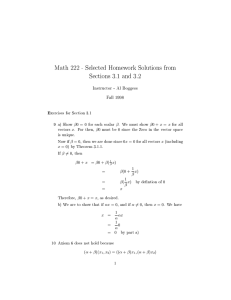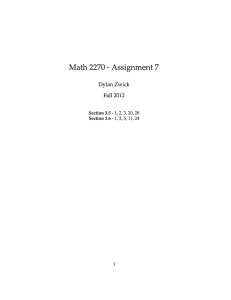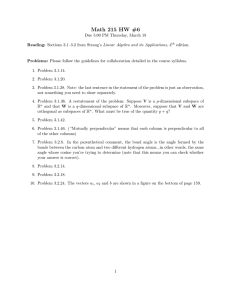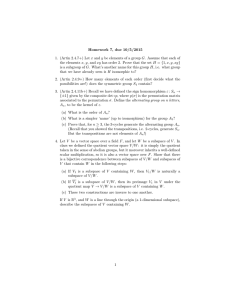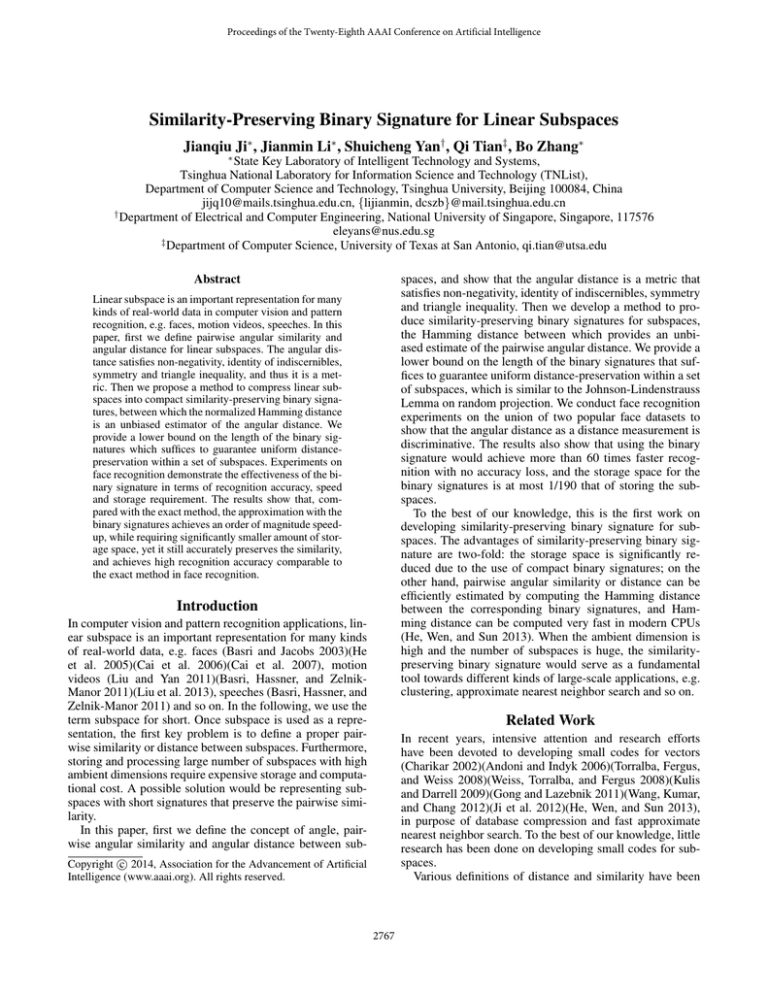
Proceedings of the Twenty-Eighth AAAI Conference on Artificial Intelligence
Similarity-Preserving Binary Signature for Linear Subspaces
Jianqiu Ji∗ , Jianmin Li∗ , Shuicheng Yan† , Qi Tian‡ , Bo Zhang∗
∗
State Key Laboratory of Intelligent Technology and Systems,
Tsinghua National Laboratory for Information Science and Technology (TNList),
Department of Computer Science and Technology, Tsinghua University, Beijing 100084, China
jijq10@mails.tsinghua.edu.cn, {lijianmin, dcszb}@mail.tsinghua.edu.cn
†
Department of Electrical and Computer Engineering, National University of Singapore, Singapore, 117576
eleyans@nus.edu.sg
‡
Department of Computer Science, University of Texas at San Antonio, qi.tian@utsa.edu
Abstract
spaces, and show that the angular distance is a metric that
satisfies non-negativity, identity of indiscernibles, symmetry
and triangle inequality. Then we develop a method to produce similarity-preserving binary signatures for subspaces,
the Hamming distance between which provides an unbiased estimate of the pairwise angular distance. We provide a
lower bound on the length of the binary signatures that suffices to guarantee uniform distance-preservation within a set
of subspaces, which is similar to the Johnson-Lindenstrauss
Lemma on random projection. We conduct face recognition
experiments on the union of two popular face datasets to
show that the angular distance as a distance measurement is
discriminative. The results also show that using the binary
signature would achieve more than 60 times faster recognition with no accuracy loss, and the storage space for the
binary signatures is at most 1/190 that of storing the subspaces.
To the best of our knowledge, this is the first work on
developing similarity-preserving binary signature for subspaces. The advantages of similarity-preserving binary signature are two-fold: the storage space is significantly reduced due to the use of compact binary signatures; on the
other hand, pairwise angular similarity or distance can be
efficiently estimated by computing the Hamming distance
between the corresponding binary signatures, and Hamming distance can be computed very fast in modern CPUs
(He, Wen, and Sun 2013). When the ambient dimension is
high and the number of subspaces is huge, the similaritypreserving binary signature would serve as a fundamental
tool towards different kinds of large-scale applications, e.g.
clustering, approximate nearest neighbor search and so on.
Linear subspace is an important representation for many
kinds of real-world data in computer vision and pattern
recognition, e.g. faces, motion videos, speeches. In this
paper, first we define pairwise angular similarity and
angular distance for linear subspaces. The angular distance satisfies non-negativity, identity of indiscernibles,
symmetry and triangle inequality, and thus it is a metric. Then we propose a method to compress linear subspaces into compact similarity-preserving binary signatures, between which the normalized Hamming distance
is an unbiased estimator of the angular distance. We
provide a lower bound on the length of the binary signatures which suffices to guarantee uniform distancepreservation within a set of subspaces. Experiments on
face recognition demonstrate the effectiveness of the binary signature in terms of recognition accuracy, speed
and storage requirement. The results show that, compared with the exact method, the approximation with the
binary signatures achieves an order of magnitude speedup, while requiring significantly smaller amount of storage space, yet it still accurately preserves the similarity,
and achieves high recognition accuracy comparable to
the exact method in face recognition.
Introduction
In computer vision and pattern recognition applications, linear subspace is an important representation for many kinds
of real-world data, e.g. faces (Basri and Jacobs 2003)(He
et al. 2005)(Cai et al. 2006)(Cai et al. 2007), motion
videos (Liu and Yan 2011)(Basri, Hassner, and ZelnikManor 2011)(Liu et al. 2013), speeches (Basri, Hassner, and
Zelnik-Manor 2011) and so on. In the following, we use the
term subspace for short. Once subspace is used as a representation, the first key problem is to define a proper pairwise similarity or distance between subspaces. Furthermore,
storing and processing large number of subspaces with high
ambient dimensions require expensive storage and computational cost. A possible solution would be representing subspaces with short signatures that preserve the pairwise similarity.
In this paper, first we define the concept of angle, pairwise angular similarity and angular distance between sub-
Related Work
In recent years, intensive attention and research efforts
have been devoted to developing small codes for vectors
(Charikar 2002)(Andoni and Indyk 2006)(Torralba, Fergus,
and Weiss 2008)(Weiss, Torralba, and Fergus 2008)(Kulis
and Darrell 2009)(Gong and Lazebnik 2011)(Wang, Kumar,
and Chang 2012)(Ji et al. 2012)(He, Wen, and Sun 2013),
in purpose of database compression and fast approximate
nearest neighbor search. To the best of our knowledge, little
research has been done on developing small codes for subspaces.
Various definitions of distance and similarity have been
c 2014, Association for the Advancement of Artificial
Copyright Intelligence (www.aaai.org). All rights reserved.
2767
proposed for subspaces (Basri, Hassner, and Zelnik-Manor
2011)(Wang, Wang, and Feng 2006)(Edelman, Arias, and
Smith 1999). The distance definition in (Wang, Wang, and
Feng 2006) is not shown to be metric, and all of these previous similarities or distances are not shown to admit a possible way to generate similarity-preserving binary signatures.
The works most related to ours are the approximate nearest subspace search methods (Basri, Hassner, and ZelnikManor 2011)(Wang et al. 2013). These methods provide
ways of conducting approximate nearest neighbor search in
terms of specific distances in a database of subspaces. However, their methods are designed specifically for approximate
nearest neighbor search, and they do not provide a compact
representation, or more specificly, binary representation for
subspaces.
The proposed binary signature for subspaces in this work
can be used in not only approximate nearest neighbor search,
but also applications where only the pairwise similarity or
distance is exploited, e.g. clustering, kernel methods. In
other words, generating binary signatures for subspaces may
be regarded as a general preprocessing step.
Then
θi = arccos(σi ), i = 1, 2, ..., dmin
Angle, Angular Similarity and Angular Distance
between Subspaces
As mentioned before, principal angles depict the relative position of two subspaces. In this section we formally define
the angle, pairwise similarity measurement and distance for
linear subspaces, based on principal angles.
Definition 1. For two subspaces P and Q of Rd , denote the
dimension dim(P) of P by dP and the dimension dim(Q)
of Q by dQ . Assume that dmax = dP ≥ dQ = dmin , and
θ1 , θ2 , ..., θdmin are the principal angles between P and Q.
Then the angle between P and Q is defined as
Pdmin
cos2 θi
θP,Q = arccos √ i=1 √
.
(3)
dmax dmin
Their angular similarity is
Pairwise Similarity Measurement for Linear
Subspaces
sim(P, Q)
Principal Angles between two Linear Subspaces
=
=
Principal angles between subspaces serve as fundamental
tools in mathematics, statistics and related applications, e.g.
data mining. The concept was first introduced by Jordan
(Jordan 1875) in 1875. Principal angles provide information
about the relative position of two subspaces. In this work,
they are the building blocks of our definition of the angle,
angular similarity and angular distance between subspaces.
Formally, for two subspaces P and Q of Rd , denote the
dimension dim(P) of P by dP and the dimension dim(Q)
of Q by dQ . Assume that dmax = dP ≥ dQ = dmin .
Then the principal angles between them, θ1 , θ2 , ..., θdmin ∈
[0, π/2], are defined recursively as (Golub and Van Loan
1996; Knyazev, Merico, and Argentati 2002):
cos(θi ) = maxui ∈P maxvi ∈Q
(2)
θP,Q
π
Pdmin
cos2 θi
1
1 − arccos √ i=1 √
.
π
dmax dmin
1−
(4)
And their angular distance is
d(P, Q)
=
=
1 − sim(P, Q)
Pdmin
cos2 θi
1
arccos √ i=1 √
.
π
dmax dmin
(5)
Since principal angles are invariant to the choice of orthonormal basis, this definition of angle, angular similarity
and angular distance is also invariant to the choice of orthonormal basis. We may regard this angle definition as
a generalization of the angle between two vectors. Indeed,
when dP = dQ = 1, this definition degenerates to the angle between two vectors. It is easy to see that the angular
distance function d(·, ·) satisfies the following three properties: non-negativity, identity of indiscernibles and symmetry.
Formally, for any subspaces O, P,Q of Rd :
Non-negativity: d(P, Q) ≥ 0
Identity of Indiscernibles: d(P, Q) = 0 if and only if
P=Q
Symmetry: d(P, Q) = d(Q, P)
Besides, later we will show that d(·, ·) also satisfies triangle inequality as described below, and thus it is a valid
metric.
Triangle Inequality: d(O, Q) ≤ d(O, P) + d(P, Q)
Note that to compute the angle θP,Q between two subspaces P and Q, it is not necessary to perform the SVD of
Pdmin
P T Q. Since kP T Qk2F = i=1
cos2 θi , we may first compute kP T Qk2F , then scale it by √d 1√d , and take the
max
min
arccos of the value.
Besides these nice properties, in the subsequent section
we will show that it is possible to generate binary signatures for subspaces, and the normalized Hamming distance
uT
i vi
kui kkvi k
subject to
uTi uj = 0 and viT vj = 0, for j = 1, 2, ..., i − 1
Principal angles between two subspaces can be computed
via singular value decomposition (Golub and Van Loan
1996; Knyazev, Merico, and Argentati 2002). Assume that
P is a d × dP matrix with orthonormal columns which form
an orthonormal basis of the subspace P, and Q is a d × dQ
matrix with orthonormal columns which form an orthonormal basis of the subspace Q. Then the cosine of each of
the principal angles equals a singular value of P T Q. Formally, assume that the reduced singular value decomposition
(SVD) of P T Q is
Y T P T QZ = diag(σ1 , σ2 , ..., σdmin ),
(1)
where 1 ≥ σ1 ≥ σ2 ≥ ... ≥ σdmin ≥ 0 are the singular values of P T Q and Y ∈ RdP ×dQ , Z ∈ RdQ ×dQ have
orthonormal columns.
2768
between the binary signatures is an unbiased estimator of the
angular distance. The experiment results on face recognition
show that the angular distance as a distance measurement is
very discriminative.
Therefore the problem of generating similarity-preserving
binary signatures for subspaces reduces to that of generating
angle-preserving binary signatures for vectors.
Sign-random-projection (Charikar 2002) is a probabilistic method for generating binary signatures for vectors.
The function is a combination of sign function sgn(·) together with a random projection. Formally, a sign-randomprojection function hv (·) : Rd → {0, 1} is defined as
Definition 3. (Charikar 2002)
hv (a) = sgn(v T a)
for any vector a ∈ Rd , where v is a d × 1 random vector, each entry of which is an independent standard normal
random variable, and sgn(·) is defined as:
1, x ≥ 0
sgn(x) =
0, x < 0
Similarity-Preserving Binary Signature for
Linear Subspaces
In this section we develop a way of producing binary signatures for linear subspaces, of which the Hamming distance
preserves the similarity. We will show that the normalized
Hamming distance between the binary signatures is an unbiased estimator of the pairwise angular distance (Definition 1) between the corresponding subspaces. We also provide a lower bound for the length of the binary signatures to
guarantee uniform distance-preservation within a set of subspaces. In addition, we also show that the angular distance
as defined satisfies triangle inequality.
Assume that P is a d × dP matrix with orthonormal
columns which form an orthonormal basis of the subspace
P, and Q is a d × dQ matrix with orthonormal columns
which form an orthonormal basis of the subspace Q. Then
we may represent subspaces P and Q by their orthographic
projection matrices P P T and QQT respectively. To generate binary signatures for P, we use an operator g(·) to transform P P T into a vector, as introduced in (Basri, Hassner,
and Zelnik-Manor 2011). For a d × d symmetric matrix Z,
the operator rearranges the elements of the upper triangular
part of Z together with the diagonal elements scaled by √12 ,
into a vector. Formally, it is defined as:
It is proven that (Goemans and Williamson 1995), for any
two given vectors a and b:
θa,b
(7)
π
T
b
), and k · k2 denotes the
where θa,b = arccos( kaka2 kbk
2
`2 -norm of a vector.
Then the function for generating binary signatures of only
1 bit for subspaces is a combination of the sign-randomprojection function hv (·) together with the operator g(·) as
defined in Definition 2, i.e. hv (g(·)) (note that here v is a
d0 × 1 vector). To be concise, we define
Definition 4. hv (P) = hv (g(P P T )).
Formally, by Lemma 1 and Equation (7), we have
P r[hv (a) = hv (b)] = 1 −
Definition 2. (Basri, Hassner, and Zelnik-Manor 2011)
0
z
z
z
g(Z) = [ √1,12 , z1,2 , ..., z1,d , √2,22 , z2,3 , ..., √d,d
]T ∈ Rd
2
where d0 = d(d + 1)/2, for any d × d symmetric matrix
Z.
P r[hv (P) = hv (Q)]
= P r[hv (g(P P T )) = hv (g(QQT ))]
θg(P P T ),g(QQT )
= 1−
π
θP,Q
= 1−
π
= sim(P, Q)
We will show that the angle between the two vectors
g(P P T ) and g(QQT ) equals the angle θP,Q between P and
Q. Formally, we have
Lemma 1. Assume that P is a d × dP matrix with orthonormal columns which form an orthonormal basis of the subspace P ⊆ Rd , and Q is a d × dQ matrix with orthonormal
columns which form an orthonormal basis of the subspace
Q ⊆ Rd . Then θg(P P T ),g(QQT ) = θP,Q .
Thus the function family hv (g(·)) is a locality-sensitive
hash family for subspaces, and by the following lemma
proven in (Charikar 2002), we have that the angular distance
d(·, ·) defined in Definition 1 satisfies triangle inequality.
Lemma 2. (Charikar 2002) For any similarity function
sim(·, ·) that admits a locality-sensitive hash family h ∈ F
operating on domain D that satisfies:
Proof. Assume that dmax = dP ≥ dQ = dmin and
θ1 , θ2 , ..., θdmin are the principal angles between P, Q.
It is shown (Basri, Hassner, and Zelnik-Manor 2011) that
Pdmin
kP P T − QQT k2F = dP + dQ − 2 i=1
cos2 θi =
T
T 2
2kg(P P ) − g(QQ )k2 .
Since 2kg(P P T )k22 = dP , 2kg(QQT )k22 = dQ ,
P r[h(a) = h(b)] = sim(a, b),
=
arccos
Pdmin
cos2 θi
√ i=1 √
dmax dmin
(9)
for any a, b ∈ D. Then 1 − sim(·, ·) satisfies triangle
inequality.
To produce binary signatures of length K for subspaces,
we need to generate K standard normal random vectors
v1 , v2 , ...vK and form a K × d0 random projection matrix
A with each viT as one row, and thus each entry of A is an
independently sampled standard normal variable. Therefore
the final function is
2kg(P P T ) − g(QQT )k22
p p
= dP + dQ − 2 dP dQ cos θg(P P T ),g(QQT ) (6)
Then θg(P P T ),g(QQT )
(8)
=
θP,Q
2769
Definition 5.
1
= sgn(A g(P P ))
=
[hv1 (P), hv2 (P), ..., hvK (P)]T
Recognition Accuracy
hA (P)
0.9
T
(10)
T
where A = [v1 , v2 , ...vK ] , and the sign function sgn(·)
is applied element-wisely to its input.
It can be shown that the normalized Hamming distance
between two binary signatures hA (P) and hA (Q) is an unbiased estimator of the angular distance between the two subspaces P and Q. Formally, by Equation (8) and the linearity
of expectation, it can be shown that
E[dH (hA (P), hA (Q))/K] =
θP,Q
= d(P, Q)
π
0.7
0.6
0.5
0.4
0.3
dq=9
dq=4
dq=13
0.2
0.1
0
0
500 1000 1500 2000 2500 3000 3500
K (number of bits)
Figure 1: Face recognition accuracy achieved by using the
binary signatures of various lengths K (number of bits) on
Extended Yale database B + PIE database, with query subspaces of dimensions dq = 4, 9, 13. The exact nearest subspace search in terms of angular distance achieves 100% accuracy for dq = 4, 9, 13.
(11)
where dH (·, ·) outputs the Hamming distance between
two binary vectors. Therefore the binary signature for subspaces is similarity-preserving.
The variance of this estimator is
250
θP,Q
θP,Q
V ar[dH (hA (P), hA (Q))/K] =
(1 −
) (12)
Kπ
π
This shows that the longer the length of the binary signatures, the smaller the variance of the estimator.
The following lemma gives a lower bound of K to ensure
that with constant probability, the binary signatures preserve
the angular distance between every pair of the subspaces in
a fixed set of n subspaces within a constant small error .
Lemma 3. For any 0 < < 1, 0 < δ < 12 and any set S of
n subspaces of Rd , let K ≥ K0 = 212 ln n(n−1)
and hA (·)
δ
as defined in Definition 5, and each entry of A is an independent standard normal variable. Then with probability at
least 1 − δ, for all P, Q ∈ S:
|dH (hA (P), hA (Q))/K − d(P, Q)| ≤ 0.8
dq=9
dq=4
dq=13
225
Speed−up−Factor
200
175
150
125
100
75
50
25
0
0
500 1000 1500 2000 2500 3000 3500
K (number of bits)
Figure 2: Speed-up-factor achieved by using the binary signatures of various lengths K (number of bits) on Extended
Yale database B + PIE database, with query subspaces of
dimensions dq = 4, 9, 13.
(13)
Proof. Denote A = [v1 , v2 , ...vK ]T . For a fixed pair of subspaces P0 , Q0 ∈ S. Define random variables
1, hvi (P0 ) 6= hvi (Q0 )
Xi =
0, hvi (P0 ) = hvi (Q0 )
Remarks: Lemma 3 can generalize to any localitysensitive hashing method that satisfies Equation (9). It shows
that to guarantee the uniform distance-preservation within a
set, the signature length K has nothing to do with the original ambient dimension of the input space, and it increases
very slowly as the size of the set grows. This is similar to the
Johnson-Lindenstrauss Lemma (Johnson and Lindenstrauss
1984; Dasgupta and Gupta 2003), a well-known theoretical
result on random projection.
for i = 1, 2, ..., K. Then dH (hA (P0 ), hA (Q0 )) =
PK
i=1 Xi . By Hoeffding’s inequality,
P r[|dH (hA (P0 ), hA (Q0 ))/K − d(P0 , Q0 )| ≥ ]
= P r[|
Experiment
K
K
1 X
1 X
Xi − E(
Xi )| ≥ ]
K i=1
K i=1
≤ 2 exp(−22 K)
In this section we demonstrate the effectiveness of the binary
signature by applying it to face recognition.
Datasets: we use the union of two face datasets, the
Extended Yale Face Database B (Georghiades, Belhumeur,
and Kriegman 2001)(Lee, Ho, and Kriegman 2005) and
the PIE database (Sim, Baker, and Bsat 2002). Note that
both of these datasets are the processed versions1 (He et al.
(14)
Denote event E = {|dH (hA (P), hA (Q))/K −
d(P, Q)| ≤ , f or all P, Q ∈ S}. Then by union bound,
P r[E] ≥ 1 − (n2 )2 exp(−22 K) ≥ 1 − δ
(15)
1
2770
http://www.cad.zju.edu.cn/home/dengcai/Data/FaceData.html
tice (He, Wen, and Sun 2013). We test different lengths K
of the binary signatures ranging from 500 to 3000.
Results: The accuracy of face recognition using the binary signatures with different lengths (number of bits) are
shown in Figure 1. Note that the exact nearest subspace
search in terms of angular distance achieves 100% accuracy
for dq = 4, 9, 13. Under different query subspace dimensions, as the length K of the binary signatures grows, the
recognition accuracy gradually increases and converges to
1. This is due to the asymptotic convergence guarantee of
the estimators produced by the binary signatures. The accuracy of dq = 9 is the highest for various lengths K, which
is slight higher than that of dq = 13 for some values of
K. Figure 2 shows the factor of speed-up over the exact
method achieved by using the binary signatures, against different lengths K, for dq = 4, 9, 13. As the query subspace
dimension grows, the speed-up-factor increases accordingly.
This is because when fixing the dimension of the subspaces
in the database, the computational cost of computing the angular distance grows approximately linearly with the query
subspace dimension: the computational cost of computing
the angular distance between two subspaces P and Q is
O(d × dP × dQ ).
When dq = 9 and K = 1500, the approximate method
using the binary signatures achieves more than 60 times
faster recognition speed than exact method, with 100%
recognition accuracy. If each entry of a vector is stored with
32 bits, then a subspace P of Rd with dimension dP requires 32 × d × dP to store (the d × dP matrix P of which
the columns form an orthonormal basis of P). In the experiment, d = 1024, dP = 9, then the storage requirement
for each subspace in the database is 294912 bits. Therefore
using the binary signatures of 1500 bits for each subspace
reduces the storage by a factor of 196. Figure 3 shows the
storage-reduction-factor achieved by using the binary signatures of various lengths K.
Storage−Reduction−Factor
600
500
400
300
200
100
0
0
500 1000 1500 2000 2500 3000 3500
K (number of bits)
Figure 3: Storage-reduction-factor achieved by using the binary signatures of various lengths K (number of bits) on
Extended Yale database B + PIE database.
2005)(Cai et al. 2006)(Cai et al. 2007)(Cai, He, and Han
2007). Each image in both datasets has been cropped and
resized to 32×32. Extended Yale Face Database B contains
38 individuals each with about 64 near-frontal images under
different illuminations. PIE database contains 68 individuals
each with 170 images under 5 near frontal poses (C05, C07,
C09, C27, C29), 43 different illumination conditions and 4
different expressions. We only use the frontal face images
(C27) from PIE database. Therefore the union of these two
datasets contains 106 individuals in total. The two datasets
have been split into training sets and testing sets respectively.
The training set of the Extended Yale Face Database B contains around 50 images per individual, and the rest (around
14) images are in the testing set. The training set of the PIE
database has about 20 images per individual, and the rest
(around 14) images are in the testing set.
Experiment Setup: each face image is vectorized to a
1024×1 vector. Several vectors of the same individual constitute a subspace. For each of these subspaces, we fit a subspace of dimension 9 by taking the first 9 principal components, and use this subspace to represent each individual in
the training set. The same goes for the testing set, except that
we test query subspaces with dimensions dq = 4, 9, 13 respectively. Thus there are 106 subspaces in the training set
and testing set respectively.
The baseline is the exact nearest subspace search method
in terms of angular distance. For each individual in the testing set (querying set), we search for the nearest subspace
in the training set (database) in terms of angular distance as
defined in Definition 1, and use its label as the prediction to
that of the query. This is done by linear scanning the training set and returning the candidate subspace with the nearest
angular distance to the query.
To test the effectiveness of the proposed binary signature,
we generate a binary signature for each subspace in the training and the testing set, and thus each subspace is now represented by a binary signature. For each query we search
for the nearest binary signature in the training set in terms
of Hamming distance. This is also done by linear scanning
the database. Since the length of the binary signatures is relatively small and Hamming distance can be computed very
efficiently, linear scan in Hamming space is very fast in prac-
Conclusion
In this paper we formally define the angular similarity and
angular distance between subspaces, and we show that the
angular distance is a metric which satisfies non-negativity,
identity of indiscernibles, symmetry and triangle inequality.
Then we propose a method to produce compact binary signatures for subspaces. The normalized Hamming distance
between the binary signatures is an unbiased estimator of the
pairwise angular distance. We provide a lower bound on the
length of the signatures which guarantees uniform angulardistance-preservation within a set of subspaces. The experiments on face recognition show that using the binary signature as representation achieves more than 60 times speedup, and a reduction of storage space by a factor of more than
190, with no loss in recognition accuracy.
Acknowledgments
This work was supported by the National Basic Research Program (973 Program) of China (Grant Nos.
2013CB329403 and 2012CB316301), the National Natural Science Foundation of China (Grant No. 61332007,
2771
61273023 and 91120011), the Beijing Natural Science
Foundation (Grant No. 4132046), and the Tsinghua University Initiative Scientific Research Program (Grant No.
20121088071). This research is partially supported by the
Singapore National Research Foundation under its International Research Centre @Singapore Funding Initiative and
administered by the IDM Programme Office. This work was
supported in part to Dr. Qi Tian by ARO grant W911NF12-1-0057, Faculty Research Award by NEC Laboratories
of America, and 2012 UTSA START-R Research Award respectively. This work was supported in part by National Science Foundation of China (NSFC) 61128007.
Conference on Computer Vision and Pattern Recognition,
817–824.
He, X.; Yan, S.; Hu, Y.; Niyogi, P.; and Zhang, H.-J. 2005.
Face recognition using laplacianfaces. IEEE Trans. Pattern
Anal. Mach. Intelligence 27(3):328–340.
He, K.; Wen, F.; and Sun, J. 2013. K-means hashing: An
affinity-preserving quantization method for learning binary
compact codes. In CVPR, 2938–2945.
Ji, J.; Li, J.; Yan, S.; Zhang, B.; and Tian, Q. 2012. Super-bit
locality-sensitive hashing. In Advances in Neural Information Processing Systems 25. 108–116.
Johnson, W. B., and Lindenstrauss, J. 1984. Extensions
of Lipschitz mapping into Hilbert space. In Conf. in modern analysis and probability, volume 26 of Contemporary
Mathematics, 189–206. American Mathematical Society.
Jordan, C. 1875. Essai sur la géométrie à n dimensions.
Bulletin de la Société Mathématique de France 3:103–174.
Knyazev, A. V.; Merico; and Argentati, E. 2002. Principal
angles between subspaces in an a-based scalar product: Algorithms and perturbation estimates. SIAM J. Sci. Comput
23:2009–2041.
Kulis, B., and Darrell, T. 2009. Learning to hash with binary
reconstructive embeddings. In Advances in Neural Information Processing Systems, 1042–1050.
Lee, K.; Ho, J.; and Kriegman, D. 2005. Acquiring linear
subspaces for face recognition under variable lighting. IEEE
Trans. Pattern Anal. Mach. Intelligence 27(5):684–698.
Liu, G., and Yan, S. 2011. Latent low-rank representation
for subspace segmentation and feature extraction. In ICCV,
1615–1622.
Liu, G.; Lin, Z.; Yan, S.; Sun, J.; Yu, Y.; and Ma, Y.
2013. Robust recovery of subspace structures by low-rank
representation. IEEE Trans. Pattern Anal. Mach. Intell.
35(1):171–184.
Sim, T.; Baker, S.; and Bsat, M. 2002. The cmu pose, illumination, and expression (pie) database. In FGR, 53–58.
Torralba, A.; Fergus, R.; and Weiss, Y. 2008. Small codes
and large image databases for recognition. In IEEE Conference on Computer Vision and Pattern Recognition, 1–8.
Wang, X.; Atev, S.; Wright, J.; and Lerman, G. 2013. Fast
subspace search via grassmannian based hashing. In The
IEEE International Conference on Computer Vision (ICCV).
Wang, J.; Kumar, S.; and Chang, S.-F. 2012. Semisupervised hashing for large-scale search. IEEE Transactions on Pattern Analysis and Machine Intelligence
34(12):2393–2406.
Wang, L.; Wang, X.; and Feng, J. 2006. Subspace distance
analysis with application to adaptive bayesian algorithm for
face recognition. Pattern Recognition 39(3):456–464.
Weiss, Y.; Torralba, A.; and Fergus, R. 2008. Spectral hashing. In Advances in Neural Information Processing Systems,
1753–1760.
References
Andoni, A., and Indyk, P. 2006. Near-optimal hashing algorithms for approximate nearest neighbor in high dimensions.
In Annual IEEE Symposium on Foundations of Computer
Science, 459–468.
Basri, R., and Jacobs, D. W. 2003. Lambertian reflectance
and linear subspaces. IEEE Trans. Pattern Anal. Mach. Intell. 25(2):218–233.
Basri, R.; Hassner, T.; and Zelnik-Manor, L. 2011. Approximate nearest subspace search. IEEE Trans. Pattern Anal.
Mach. Intell. 33(2):266–278.
Cai, D.; He, X.; Han, J.; and Zhang, H.-J. 2006. Orthogonal
laplacianfaces for face recognition. IEEE Transactions on
Image Processing 15(11):3608–3614.
Cai, D.; He, X.; Hu, Y.; Han, J.; and Huang, T. 2007. Learning a spatially smooth subspace for face recognition. In
Proc. IEEE Conf. Computer Vision and Pattern Recognition
Machine Learning (CVPR’07).
Cai, D.; He, X.; and Han, J. 2007. Spectral regression for
efficient regularized subspace learning. In Proc. Int. Conf.
Computer Vision (ICCV’07).
Charikar, M. 2002. Similarity estimation techniques from
rounding algorithms. In ACM Symposium on Theory of
Computing, 380–388.
Dasgupta, S., and Gupta, A. 2003. An elementary proof
of a theorem of johnson and lindenstrauss. Random Struct.
Algorithms 22(1):60–65.
Edelman, A.; Arias, T. A.; and Smith, S. T. 1999. The geometry of algorithms with orthogonality constraints. SIAM
J. Matrix Anal. Appl. 20(2):303–353.
Georghiades, A.; Belhumeur, P.; and Kriegman, D. 2001.
From few to many: Illumination cone models for face recognition under variable lighting and pose. IEEE Trans. Pattern
Anal. Mach. Intelligence 23(6):643–660.
Goemans, M. X., and Williamson, D. P. 1995. Improved approximation algorithms for maximum cut and satisfiability
problems using semidefinite programming. Journal of the
ACM 42(6):1115–1145.
Golub, G. H., and Van Loan, C. F. 1996. Matrix Computations (3rd Ed.). Johns Hopkins University Press.
Gong, Y., and Lazebnik, S. 2011. Iterative quantization:
A procrustean approach to learning binary codes. In IEEE
2772



